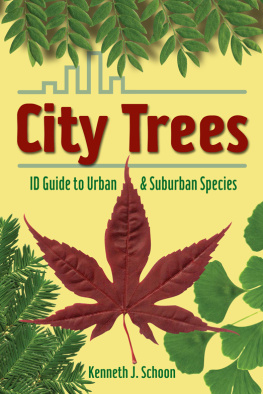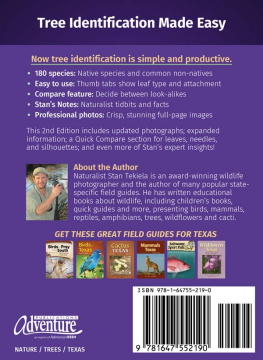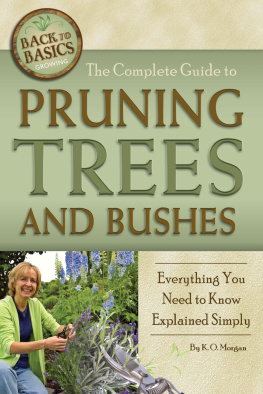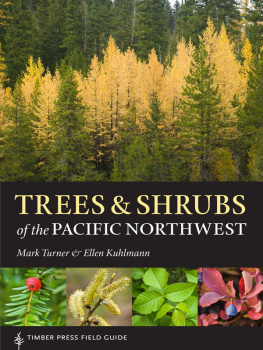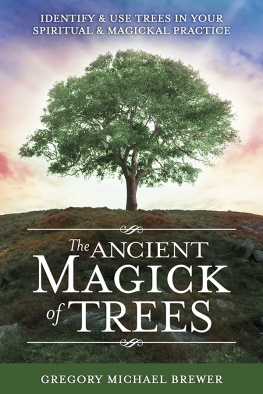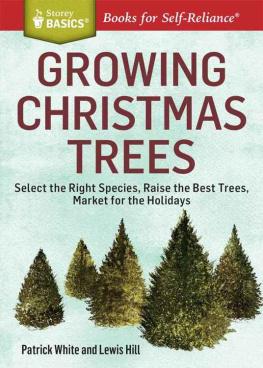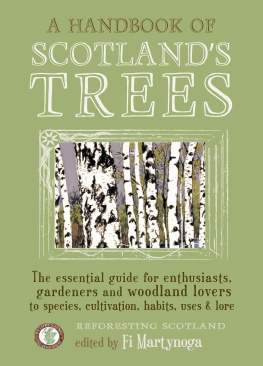Kenneth J. Schoon - City Trees: Id Guide to Urban & Suburban Species
Here you can read online Kenneth J. Schoon - City Trees: Id Guide to Urban & Suburban Species full text of the book (entire story) in english for free. Download pdf and epub, get meaning, cover and reviews about this ebook. year: 2011, publisher: Stackpole Books, genre: Children. Description of the work, (preface) as well as reviews are available. Best literature library LitArk.com created for fans of good reading and offers a wide selection of genres:
Romance novel
Science fiction
Adventure
Detective
Science
History
Home and family
Prose
Art
Politics
Computer
Non-fiction
Religion
Business
Children
Humor
Choose a favorite category and find really read worthwhile books. Enjoy immersion in the world of imagination, feel the emotions of the characters or learn something new for yourself, make an fascinating discovery.
- Book:City Trees: Id Guide to Urban & Suburban Species
- Author:
- Publisher:Stackpole Books
- Genre:
- Year:2011
- Rating:3 / 5
- Favourites:Add to favourites
- Your mark:
- 60
- 1
- 2
- 3
- 4
- 5
City Trees: Id Guide to Urban & Suburban Species: summary, description and annotation
We offer to read an annotation, description, summary or preface (depends on what the author of the book "City Trees: Id Guide to Urban & Suburban Species" wrote himself). If you haven't found the necessary information about the book — write in the comments, we will try to find it.
City Trees: Id Guide to Urban & Suburban Species — read online for free the complete book (whole text) full work
Below is the text of the book, divided by pages. System saving the place of the last page read, allows you to conveniently read the book "City Trees: Id Guide to Urban & Suburban Species" online for free, without having to search again every time where you left off. Put a bookmark, and you can go to the page where you finished reading at any time.
Font size:
Interval:
Bookmark:
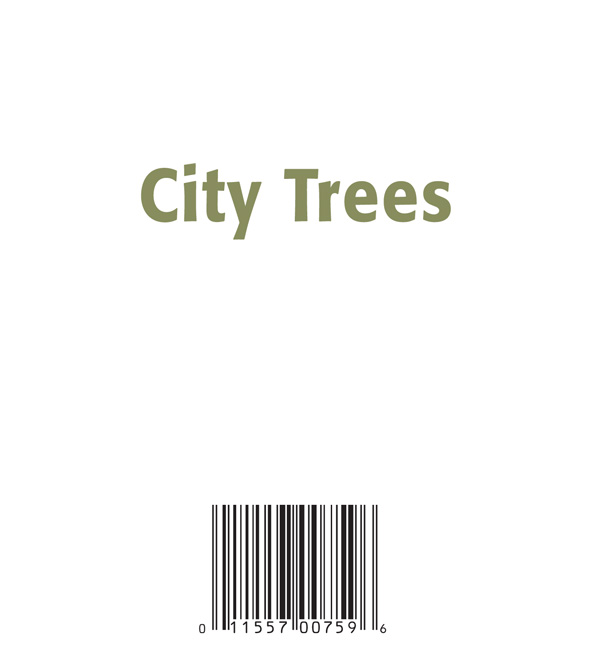
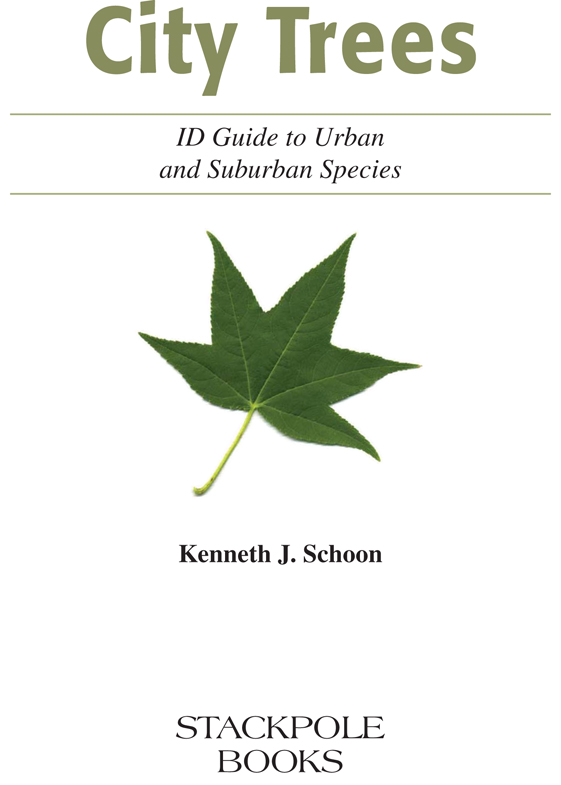
Copyright 2011 by Stackpole Books
Published by
STACKPOLE BOOKS
5067 Ritter Road
Mechanicsburg, PA 17055
www.stackpolebooks.com
All rights reserved, including the right to reproduce this book or portions thereof in any form or by any means, electronic or mechanical, including photocopying, recording, or by any information storage and retrieval system, without permission in writing from the publisher. All inquiries should be addressed to Stackpole Books, 5067 Ritter Road, Mechanicsburg, PA 17055.
Printed in the United States of America
Cover design by Caroline Stover.
10 9 8 7 6 5 4 3 2 1
First edition
Library of Congress Cataloging-in-Publication Data
Schoon, Kenneth J.
City trees : an ID guide to urban and suburban species / Kenneth Schoon. 1st ed.
p. cm.
Includes bibliographical references and index.
ISBN 978-0-8117-0759-6
eISBN 978-0-8117-4485-0
1. Trees in cities. 2. TreesIdentification. I. Title.
SB436.S35 2011
635.9'77dc22
2011000181
Acknowledgments
I am grateful to the following people for help in compiling and producing this book: Dianne Cutler, grounds supervisor at Indiana University Northwest; John Bachmann, grounds supervisor at Purdue University Calumet; Jim Hitz, Executive Director at Taltree Arboretum and Gardens, Indiana; Tom Allen, owner, and Lois Welch, of Allen Landscape, in Highland, Indiana; professional forester Gina Darnell; botanist Naida Lehmann; Ann Allen, Public Works Office Manager at Valparaiso, Indiana; Michelle Buckstrup Sutton, editor of City Trees magazine; John Chupek, Operations Manager, and Michael Mather, Board Certified Master Arborist, Urban Forestry Division, Richmond, Virginia; Brighton West, Friends of Trees at Portland, Oregon; photographers Beth Koebel, MD, and David Cappaert; Anne Koehler, Head of System Services, Indiana University Northwest Library; Aaron Pigors, Instructional Media Center at Indiana University Northwest; and several dozen others whose names I dont know who helped me access tree inventories of various communities. It was through these tree censuses that I was able to determine which trees are common in urban and suburban communities across the Midwest and northeastern portions of North America. I am especially grateful to Peg Schoon, a librarian and my wife of 40 years, who found much of the information in the third section and proofread the manuscript several times.
Introduction
A tree is a plant that grows to a height of at least 10 feet and has, from top to bottom, a crown of branches and leaves, generally one trunk several inches in diameter, and roots. Several tree species may grow to heights of over 100 feet.
Leaves are the food factories of the tree. It is in the leaves that water and minerals brought up from the ground and carbon dioxide from the air are converted (with the aid of sunlight) into sugary sap (the trees food) and oxygen, which is then released into the air. The chemical that makes this happen, chlorophyll, is also what makes leaves green. Leaves come in many different sizes and shapes, and although most are green, some may be red or purple or even appear blue. Different species of trees have differently shaped leavesa fact that is very useful in tree identification.
The trunk supports the upper part of the tree in two important ways. Most obvious is that it physically holds up the branches. But support also comes in the form of transportation. Within the trunk are structures called xylem, which transports water and dissolved minerals from the roots to the leaves, and phloem (also called the inner bark), which transports the sap downward to the roots. Surrounding the trunk is the tough outer bark, which protects the inner structures.
Roots usually spread in all directions from the trunk and hold the tree to the soil. Some trees have a large, long taproot that grows straight downward (just as a trunk grows upward). These trees are hard to dig up and transplant and so are not usually sold at landscaping centers. Other tree roots do not go directly downward but instead spread out in all directions rather close to the surface (these surface roots can cause nearby sidewalks to buckle). Roots, of course, provide the tree with water and minerals, which are absorbed by tiny root hairs at the ends of the roots. Roots serve another function: On sloping surfaces such as hills or steep slopes near rivers or ditches, roots cling to the soil and help prevent erosion.

Types of Trees
Evergreen trees are well knownthey are the trees that bear living leaves (sometimes needles) year-round. Evergreen trees do drop their leaves, but new ones are formed before the old ones fall. Deciduous trees are those that drop their leaves every year. They are bare in winter and grow new leaves each spring. Conifers are those whose seeds are formed in cones and whose leaves are either needles (like pine trees) or overlapping scales (like arborvitae). Most conifers are evergreenbut not all. The baldcypress is a conifer with needles that turn brown and fall from the tree every autumn. It looks like an evergreen in the summer but not in the winter.
The Urban Forest
It is in cities and suburban communities that most people today have their first experiences with trees. It is here that kids first learn about nature and are fascinated by falling maple seed helicopters. It is here that they learn about seasons by noting when new leaves form and old leaves fall, and it is here that they collect leaves for a school leaf collection. Older kids may earn spending money by raking leaves or help with the planting of new trees from a garden center.
The urban forest is quite different from the natural forests of North America. Trees in the natural forest are primarily native American trees (although a few nonnative trees have begun to infiltrate forests). The trees in a city are like the people in a city: They come from many different parts of the world. Although the city may contain, in places, remnants of a natural landscape, with the original forest trees still in place, most of the urban forest is the direct result of human planning and action. Most urban trees arrive at their location on a truck.
These trees have certain desirable characteristics. For many years, the American elm was the tree of choice in midwestern and northeastern cities. It grew dependably into a healthy, beautiful shade tree with a vaselike shape. Elms remained Americas dominant city tree until the mid-1900s, when they were largely destroyed by Dutch elm disease. Another common city tree today, the silver maple, is a relatively inexpensive, fast-growing tree that also grows to a good size. For many decades now, silver maples have been planted in cities, especially in brand-new, treeless neighborhoods, because they can, within a few years, turn a bare street into a pleasant, semi-wooded one.
Smaller ornamental trees make up a big part of the urban forest. Magnolias, flowering pears, and crabapples welcome each spring with an abundance of white and pink flowers. Their smaller size works well with landscape designs for yards and in islands in parking lots. Other trees, including the honeylocust, weeping willow, and ginkgo, with their distinctive shapes, are chosen because they add visual interest to streetscapes. Oak trees may be chosen because they hold onto a portion of their leaves through much of the winter. Evergreen trees are often chosen because their color is maintained all year.
Font size:
Interval:
Bookmark:
Similar books «City Trees: Id Guide to Urban & Suburban Species»
Look at similar books to City Trees: Id Guide to Urban & Suburban Species. We have selected literature similar in name and meaning in the hope of providing readers with more options to find new, interesting, not yet read works.
Discussion, reviews of the book City Trees: Id Guide to Urban & Suburban Species and just readers' own opinions. Leave your comments, write what you think about the work, its meaning or the main characters. Specify what exactly you liked and what you didn't like, and why you think so.

